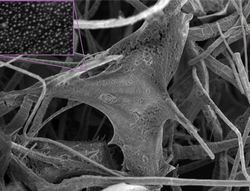Regenerative aerographite-based scaffolds
Tissue engineering is currently the cutting edge technology in biomedicine. New biomaterials are being developed to repair damaged tissues and organs and restore functionality. Aerographite is a carbon-based material whose architecture can be tailored. It has a self-supportive 3D network of interconnected hollow microtubes. During the GRAPHITE4MED (Aerographite as scaffold material for regenerative medicine) project, researchers tested the feasibility of using aerographite as a scaffold material in implants to direct cell growth. In other words, they intended this material to act like the natural extracellular matrix (ECM) in the body. Researchers successfully resolved a major technical issue with using aerographite as a biomaterial – its water-repellent nature. They exploited amphiphilic molecules with poly(ethylene glycol) (PEG) to ensure that aerographite can immerse in aqueous solutions. Another key aspect addressed included aerographite functionalisation to facilitate cell attachment, migration and multiplication on the scaffold. GRAPHITE4MED researchers used the cyclic tri-peptide cRGD on the surface of the microtubes in this material. RGD is found in many proteins present in the natural ECM and mediates cell adhesion. On seeding of fibroblasts onto the aerographite scaffolds, they found that cells grew and migrated into the scaffold. In vitro cytotoxicity testing revealed that human neuronal cells have a high tolerance for fragmented aerographite unlike epithelia, connective tissue and bone cells. Study outcomes were presented at several international conferences as well as expert panels. Even beyond the end of the project, GRAPHITE4MED researchers intend to determine the workplace and environmental safety requirements for this material. Project outcomes have highlighted the potential of aerographite in neuronal regeneration. Neurodegenerative disorders and nerve injuries are still a major challenge and this finding is like a light at the end of the tunnel for such patients.







